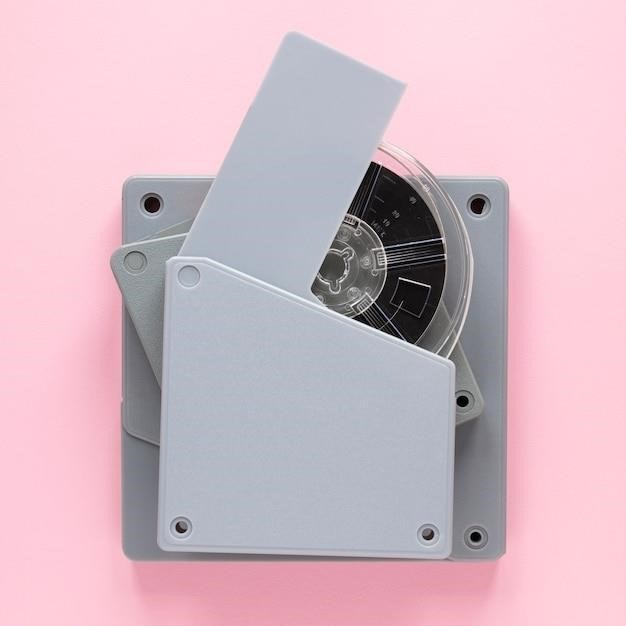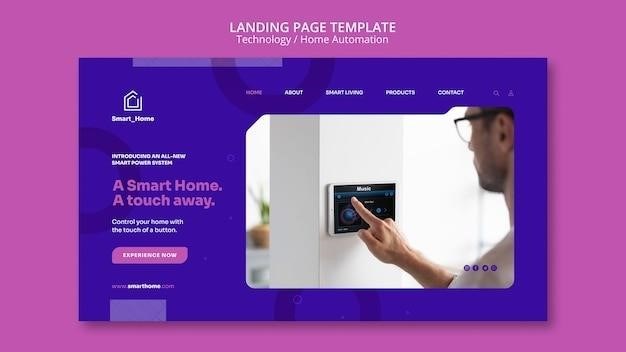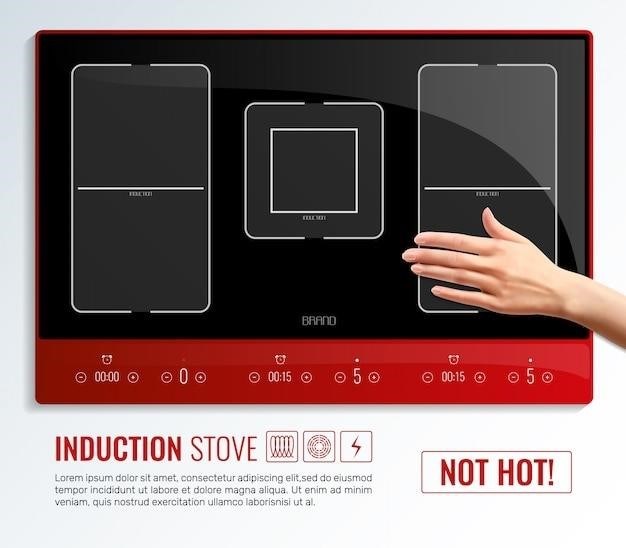presto precise digital pressure canner manual
Category : Manuals
Presto Precise Digital Pressure Canner⁚ A Comprehensive Guide
This guide provides a complete overview of the Presto Precise Digital Pressure Canner, covering setup, operation, safety, troubleshooting, and maintenance. Learn how to safely can low-acid foods and utilize its boiling water canning function. Detailed instructions and helpful tips are included for beginners.
Product Overview and Specifications
The Presto Precise Digital Pressure Canner (model 02144) is a 12-quart (11.4-liter) electric pressure canner designed for home canning. Operating at 120 volts AC with a power rating of 1485 watts, it simplifies the canning process with automated features. This innovative appliance is the first digital pressure canner to meet USDA home canning guidelines for safely processing low-acid foods like meats, poultry, fish, and vegetables, eliminating the need for altitude adjustments. Its versatility extends to boiling water canning, making it suitable for preserving fruits, jams, jellies, and salsa. The digital interface provides clear instructions, guiding users through each step. A temperature sensor ensures precise temperature control for both pressure and boiling water canning methods, guaranteeing safe and consistent results. The user-friendly design and automated features make it ideal for both beginners and experienced canners seeking a reliable and efficient electric pressure canner.
Safety Precautions and Important Notes
Before operating your Presto Precise Digital Pressure Canner, carefully read the complete instruction manual. Always ensure the canner is placed on a stable, heat-resistant surface away from flammable materials. Never operate the canner without sufficient water; low water levels can cause damage. Use only recommended jars and lids in good condition; damaged jars or lids can compromise safety. Avoid overfilling jars, leaving proper headspace as specified in canning recipes. Always follow USDA guidelines for processing times and temperatures. Never attempt to force the lid open while pressure remains; allow pressure to release naturally. If the lid lock fails to release, turn off the canner and allow it to cool completely before attempting to open it. Regularly inspect the sealing ring and replace it as needed. Never leave the operating canner unattended. Keep children and pets away from the operating appliance. Always use caution when handling hot jars and steam. Allow jars to cool completely before handling after canning. In case of malfunction or any unusual occurrence, immediately disconnect the power and contact customer service.
Setting Up and Preparing the Canner
Begin by unpacking your Presto Precise Digital Pressure Canner and inspecting all parts for any damage. Ensure the power cord is undamaged and properly connected. Place the canner on a stable, level surface, ensuring adequate ventilation around the unit. Fill the canner with the appropriate amount of water, as specified in the instruction manual, based on the number and size of jars being processed. This water level is crucial for safe and efficient operation; insufficient water can lead to damage. Position the canning rack inside the canner; this rack elevates the jars, ensuring even heat distribution and preventing direct contact with the bottom of the canner. Carefully place prepared jars filled with your chosen food onto the canning rack. Ensure the jars are not overcrowded, allowing for proper space between them. Securely close the lid of the canner, ensuring the locking mechanism engages correctly. Before powering on, double-check that all components are correctly assembled and the water level is correct. Consult the manual for specific instructions regarding the placement of the pressure regulator and vent pipe. Familiarize yourself with all control features and settings before starting the canning process.
Pressure Canning Low-Acid Foods⁚ A Step-by-Step Guide
After setting up the canner as described previously, select the “Pressure Canning” mode on the digital control panel. Input the recommended processing time for your specific low-acid food and jar size, referring to a reliable canning guide or USDA guidelines. Ensure the pressure regulator is correctly installed and the vent pipe is clear. Close the lid securely and turn the canner on. The canner will automatically heat and build pressure; observe the pressure gauge to monitor the process. Once the target pressure is reached, the canner will maintain it for the duration of the processing time. During this phase, avoid opening the lid or interrupting the process. Once the timer completes, the canner will begin the automatic pressure release cycle. Do not manually vent the pressure before the automatic cycle is complete. This is crucial for food safety. After the pressure has fully released, and the pressure gauge reads zero, carefully open the lid, slightly tilting it away from you to avoid steam burns. Remove the jars and allow them to cool completely before inspecting for proper sealing. Listen for a distinct “pop” sound, indicating a successful seal. Improperly sealed jars should be refrigerated and consumed immediately.
Boiling Water Canning⁚ Fruits, Jams, and Jellies
The Presto Precise Digital Pressure Canner also functions as a boiling water canner, ideal for preserving high-acid foods like fruits, jams, jellies, and some salsas. Before beginning, ensure your jars and lids are sterilized according to recommended procedures. Select the “Boiling Water Canning” mode on the control panel. Fill the canner with enough water to cover the jars by at least one inch, ensuring the jars are completely submerged. Carefully place the filled jars on the canning rack, avoiding overcrowding. Close the lid securely. The canner will automatically heat the water to a rolling boil, maintaining the temperature throughout the processing time. Refer to a reliable canning guide or USDA guidelines for accurate processing times based on the specific food and jar size. Once the processing time is complete, carefully turn off the canner. Allow the jars to cool completely inside the canner, undisturbed, to prevent breakage and ensure proper sealing. After cooling, remove the jars and listen for the tell-tale “pop” sound that indicates a successful seal. Any jars that haven’t sealed should be refrigerated and consumed promptly. Always follow established safe canning practices to prevent spoilage and foodborne illness.
Troubleshooting Common Issues and Error Codes
The Presto Precise Digital Pressure Canner features error codes to alert you to potential problems. An E50 error typically indicates a faulty sealing ring, requiring replacement. If the canner fails to build pressure, check the sealing ring for damage or debris, ensuring a proper seal. Inspect the vent pipe for blockages. Insufficient water can also hinder pressure build-up; always ensure adequate water coverage. If the pressure gauge isn’t working correctly, consult the manual for specific troubleshooting steps or contact customer support. Remember that uneven heating can lead to inconsistent pressure; ensure the canner is placed on a stable, level surface and the heat source is appropriately adjusted. Always allow the pressure to release naturally before opening the lid to avoid burns and potential damage. If you encounter persistent issues or unfamiliar error codes, refer to the comprehensive troubleshooting section within the user manual or contact Presto customer service for assistance. Never attempt to force the lid open; this could lead to injury and damage the appliance. Proper maintenance, including regular cleaning and inspection of components, will help to prevent many common issues.
Cleaning and Maintenance of the Canner
Regular cleaning and maintenance are crucial for the longevity and safe operation of your Presto Precise Digital Pressure Canner. After each use, allow the canner to cool completely before attempting any cleaning. Never immerse the control panel or electrical components in water. Wipe the exterior with a damp cloth and mild detergent, then dry thoroughly. The interior can be cleaned with warm soapy water and a non-abrasive sponge or brush; Pay close attention to the sealing ring, ensuring it’s free from food particles and thoroughly cleaned. Inspect the sealing ring for any signs of wear and tear; replace it if necessary to maintain a proper seal and prevent leaks. The canning rack can be washed separately in warm soapy water. Ensure all parts are completely dry before storing. Avoid using abrasive cleaners or scouring pads, as these can damage the canner’s surface. Periodically check the vent pipe for any blockages and clean as needed. Storing the canner in a cool, dry place will help prevent rust and corrosion. Following these simple cleaning and maintenance steps will help ensure your Presto Precise Digital Pressure Canner remains in optimal condition and provides years of safe and reliable service. Regular maintenance will enhance its performance and extend its lifespan.
Recipes and Canning Tips for Beginners
Embarking on your pressure canning journey with the Presto Precise can be both rewarding and delicious! Start with simple recipes like pickled green beans or dilly beans; these are forgiving and perfect for mastering the basics. Always follow tested recipes from reputable sources, ensuring accurate processing times and pressures for safe canning. Before you begin, thoroughly sterilize your jars and lids in boiling water for at least 10 minutes. Using a jar lifter prevents burns and broken jars. Ensure your jars are properly filled, leaving the recommended headspace to avoid overflows during processing. Tighten lids fingertip-tight; over-tightening can lead to issues. Always check your canner’s gauge during processing to ensure consistent pressure. Once the processing cycle is complete, allow the pressure to naturally release before opening the canner. Properly sealed jars will have concave lids. Store your canned goods in a cool, dark, and dry place. Don’t be afraid to experiment once you’ve mastered the fundamentals! Start with smaller batches to build confidence and avoid overwhelming yourself. Consult the Presto Precise manual for detailed instructions and safety guidelines. With practice and attention to detail, you’ll soon be preserving your homegrown harvest with confidence and enjoyment. Remember, safe canning practices are paramount!
Understanding Pressure and Temperature in Canning
Pressure canning is crucial for safely preserving low-acid foods like vegetables and meats. The Presto Precise Digital Canner uses a temperature sensor to maintain the precise temperature necessary to destroy harmful bacteria. Unlike traditional pressure canners that rely solely on pressure gauges, this digital model prioritizes temperature control, ensuring consistent and safe processing. Understanding the relationship between pressure and temperature is key to successful canning. Higher pressure correlates to higher internal temperatures within the canner. This elevated temperature is essential for eliminating spoilage organisms. The Presto Precise automatically maintains the required temperature, eliminating the guesswork associated with altitude adjustments. This feature ensures consistent results regardless of your location. The digital display provides real-time temperature readings, allowing you to monitor the process and ensuring food safety. Improper pressure or temperature can lead to spoilage or even the risk of botulism, a severe form of food poisoning; Always adhere to the recommended processing times and temperatures specified in reliable canning recipes. The user manual contains detailed explanations and troubleshooting tips. Mastering this crucial aspect of pressure canning will guarantee the safety and quality of your home-preserved goods.
Altitude Adjustments and Considerations
Altitude significantly impacts boiling points; water boils at a lower temperature at higher elevations. This affects canning because achieving the necessary temperature for sterilization requires longer processing times at higher altitudes. Traditional pressure canners often require manual adjustments based on altitude to compensate for this difference. However, the Presto Precise Digital Pressure Canner eliminates the need for these manual adjustments. Its advanced digital controls automatically compensate for variations in altitude, ensuring consistent processing regardless of your location. The internal temperature sensor precisely monitors and maintains the required temperature for safe canning, even at high altitudes. This simplifies the canning process and removes the potential for errors associated with manual altitude calculations. While the canner automatically adjusts, understanding the underlying principle is beneficial. Higher altitudes mean lower boiling points, necessitating longer processing times to achieve the same level of sterilization as at sea level. The Presto Precise’s automated system handles this complexity, ensuring consistent results and providing peace of mind. You can confidently preserve your food at any elevation without compromising safety or quality. Always consult a reliable, altitude-adjusted canning recipe for accurate processing times.
Comparing the Presto Precise to Other Electric Canners
The Presto Precise Digital Pressure Canner distinguishes itself from other electric canners through its unique features and capabilities. Unlike many electric models that simply maintain a set temperature, the Presto Precise uses a sophisticated temperature sensor to ensure accurate and consistent heat distribution throughout the canning process. This precision is crucial for safe and effective sterilization of low-acid foods. Many competitors lack this level of automated control, often requiring manual adjustments or leaving room for inconsistencies. Furthermore, the Presto Precise’s automatic venting system simplifies the process and minimizes the risk of errors compared to models requiring manual venting. This automated feature contributes significantly to user-friendliness and safety. While other electric canners might offer similar boiling water canning functionalities, the Presto Precise’s integrated pressure and boiling water capabilities in a single unit streamline the overall canning process. The combination of automatic pressure and temperature control sets it apart, making it a superior choice for home canners prioritizing safety, convenience, and precise results. Consider comparing the Presto Precise’s features, including its automated altitude adjustment, to those of other electric canners before making a purchase decision. This comparison will highlight the Presto Precise’s technological advantage.
User Reviews and Testimonials
Online reviews consistently praise the Presto Precise Digital Pressure Canner for its ease of use and reliable performance. Many users highlight the automated features, emphasizing how the digital controls and automatic venting significantly simplify the canning process, reducing the risk of human error. Positive feedback frequently mentions the accurate temperature control, ensuring consistent results and safe processing of low-acid foods. The unit’s dual functionality, serving as both a pressure canner and boiling water canner, is another frequently cited advantage, offering versatility for various canning needs. However, some users note that the canner’s height might limit the use of larger jars, requiring careful consideration of jar size. A few reviews mention occasional minor issues with the sealing mechanism, though these appear to be isolated incidents. Overall, the overwhelming consensus among users points to the Presto Precise as a reliable and user-friendly appliance that simplifies home canning. The positive feedback consistently emphasizes the automated features, ease of use, and the reduction in errors compared to traditional methods. Many users attest to its ability to deliver consistent and safe results, making it a valuable tool for both beginners and experienced canners. The convenience and accuracy offered by this digital canner are significant factors in the positive user experience.
Where to Buy and Obtain Replacement Parts
The Presto Precise Digital Pressure Canner is widely available for purchase at various retailers, both online and in physical stores. Major online marketplaces like Amazon and Walmart often carry the canner, offering competitive pricing and customer reviews. Many kitchen supply stores and home goods retailers also stock the Presto Precise, providing the opportunity for in-person inspection before purchase. Checking local appliance stores or department stores in your area is another avenue for finding the canner. For replacement parts, such as the sealing ring or other components, Presto’s website offers a comprehensive parts list and ordering system. Contacting Presto customer service directly is another reliable option for sourcing replacement parts, as their representatives can help identify the necessary component and guide you through the ordering process. Alternatively, some online retailers that sell the canner may also offer replacement parts. Always ensure you purchase genuine Presto parts to maintain the safety and functionality of your canner. Using non-genuine parts could compromise the performance and void any warranty.

















